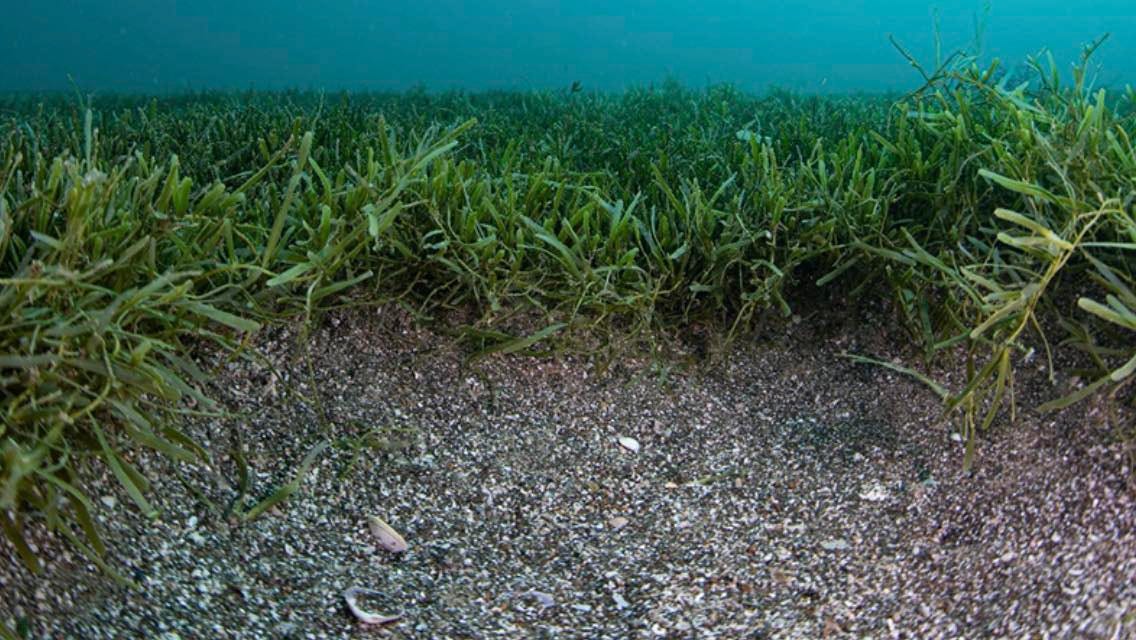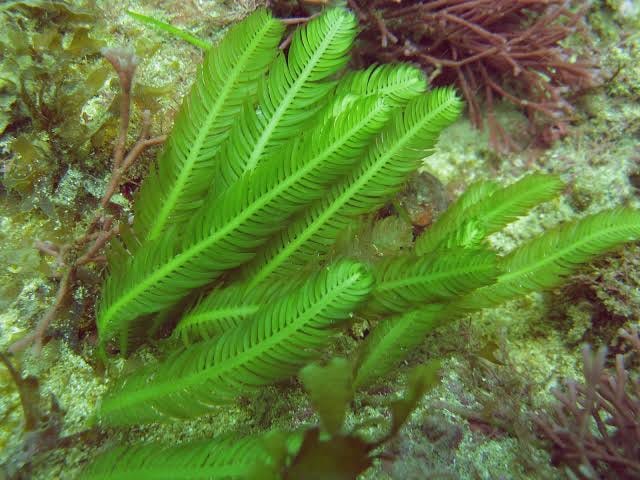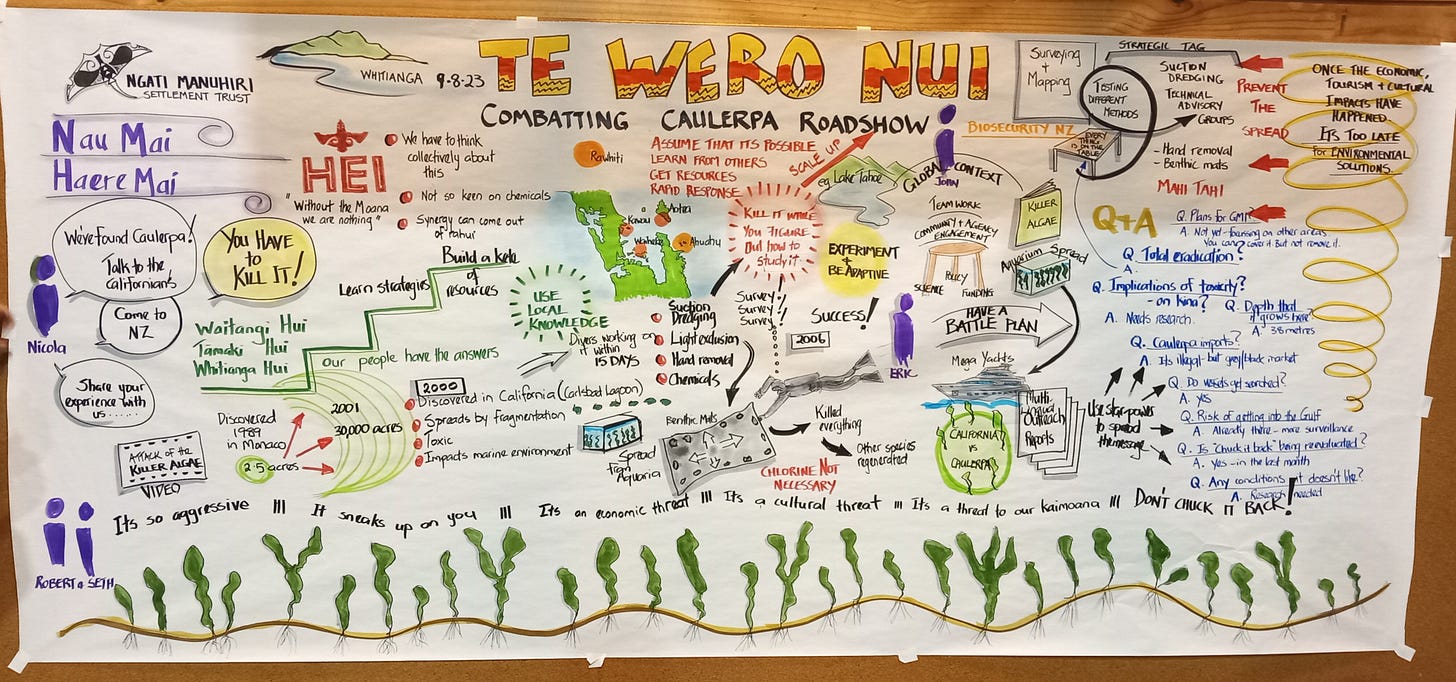CAULERPA : THE BATTLE FOR THE BOTTOM OF THE SEA 🌿 🌊 🌏
Did you know there is an important battle being fought on multiple fronts, deep beneath the surface of the oceans of Planet Earth? 🤔
A NEW ENEMY 🧐
Did you know there is an important battle being fought on multiple fronts, deep beneath the surface of the oceans of Planet Earth? 🤔
A power struggle with an expansionist alien force which, if lost, could potentially spell out, in bold capital letters, certain doom for many aspects of human society, diet, and culture?
No, I'm not talking about anything extraterrestrial or interdimensional (for a change 😅) , or anything you might've heard or seen in a particular United States court hearing a couple of weeks ago. This is 100% an Earth problem. Or, more accurately, an Ocean problem.....
So, if you care about the fish and all that, I'd keep reading.
But first, I'd share this post 👇
CALL-WHAT-A-PA???
I'd never even heard the word Caulerpa (pronounced "Call-Err-Puh". I think 😂) until the other day.
Sounds like a damn vegetable.
Looks like one too.
But this rather innocuous organism, which resembles a noded, stalky grass, poses a major threat to the worldwide marine and seabed environment.
According to Uncle Google, Caulerpa is a genus of seaweeds in the family Caulerpaceae. What makes this genus perculiar is that they consist of only one cell with many nuclei, making them among the biggest single cell organisms in the world!
One of the species in question is called Caulerpa Taxifolia.
Caulerpa Taxifolia (anything with Tax in it's name has gotta be bad) is native to the Carribean region and is a highly invasive species of algae which is sold commercially as an aquarium plant.
It was first observed spreading to plague proportions near Monaco on the Mediterranean Sea. In the year 1989, a patch of the algae roughly 2.5 acres in size was located off the coast of Monaco. By the year 2001, this patch had grown to being around 30,000 acres in size.
Now that's some exponential growth.
It is believed to possibly have first made it to the Med through the cleaning of aquariums on board luxury super yachts, or spread from a local aquarium in Monaco, though this has not been proven.
It then proceeded to effectively decimate the entire Mediterranean marine ecosystem through smothering of native species.
The response to combat and kill it came far too late and the battle was futile.
In the year 2000, it was discovered in Southern California at Carlsbad Agua Hedionda Lagoon in San Diego County, and then later in Huntington Harbor at Huntington Beach in Orange County, California. It's now been found in other areas such as Long Beach and Newport Beach, as well as Florida.
In the first case mentioned above, the infestation of Carlsbad Lagoon, they were able to successfully eradicate the algae and reinstate its original inhabitants.
Since then, its been discovered in Italy, France, Australia and, rather unfortunately, New Zealand.
It was first found to be lurking in NZ waters in 2021, and was first found at Aotea (Great Barrier Island), and then Ahuahu (Great Mercury Island) not long after. It has since been uncovered in the Te Rāwhiti inlet at Bay Of Islands, Kawau Island, and Waiheke Island.
This stuff doesn't muck around.
Taxifolia is not the only problem species of this genus, with a couple of others being identified as invasive, such as the Caulerpa Brachypus and Caulerpa Parvifolia varieties found in NZ waters.
Here in Aotearoa, it is a huge existential threat to our native shellfish, native sea grasses, kelp, seaweeds, and also, our own native Caulerpa species, of which there are around 9 varieties.
It can also negatively affect societies of fish and marine life, throwing ecosystems out of balance and has already been found to decrease the numbers of in fauna invertebrates living in the mud and sand, even though they do not directly rely on the Caulerpa itself.
Caulerpa grows like a fungus, with rhizome resemblant of mycelium which form a vast network beneath the surface and spread like wild fire, producing many plants as can be seen below.
THE BATTLE PLAN 🛡
On Thursday night, I attended the Combatting Caulerpa Roadshow, which is being run by the Ngati Manuhiri Settlement Trust and is an amazing, pro-active initiative which is travelling the country raising awareness and providing communities with the tools and knowledge to (hopefully 🤞) successfully eradicate the seething, green menace of a weed.
Present were three Marine Scientists who have come all the way from California to share their most valuable insights and help prepare us for the long journey ahead. These men have been instrumental in the success of eradicating Caulerpa outbreaks in lagoons and lake environments of wider California, and also rescuing the much loved Lake Tahoe from noxious grasses and reinstating the native grass species.
Sounds like important work to me….
After a karakia (Māori blessing) to open the event, we heard from Nicola, a Ngati Manuhiri woman who is the Acting CEO and Co - Chair of the Hauraki Gulf Forum and is responsible for the Combatting Caulerpa Roadshow and was behind the initiative to bring the Californian scientists over to NZ.
First, we heard from two scientists, who’s names (sorry guys 🤷♂️) avoided my radar, but who provided an in depth analysis of Caulerpa Taxifolia and their battle with it in the US. It was an amazingly informative talk, and personally I learned heaps. These two men gave us a highly detailed overview of the background and nature and characteristics of Caulerpa algae.
Then Eric Noel Muñoz took the floor.
Eric, who has a degree in physical geography from San Diego State University, is a Town Planner from Carlsbad, California.
He is a self described ocean lover and is the author of a book titled Destructive Seaweed Threatens California.
Eric speaks to the crowd in Whitianga, NZ
He first provided a brief technical analysis of the circumstances involved with the infestations of Carlsbad Lagoon, including the theory that the invasive algae may have originally made its way into the body of water by way of a large drainage pipe.
Also, there is a nuclear power plant right by the lagoon, which doesn't seem to have worried the Caulerpa.
It is thought Caulerpa may possibly be able to consume some pollutants, but more research is needed in this area to clarify whether it may be applied in cleaning up pollution spills or leaks.
He explained how the popular aquarium plant most likely made its way into the Mediterranean through the cleaning of residential aquariums.
People have seaside aquariums and when they clean them, they tip the used water directly into the sea.
Just a 2mm sized piece of Caulerpa fragment can establish itself and grow into an entire plant. A piece the size of a fingernail can multiply to the size of a football field in quite little time.
Eric also explained his personal hypothesis that the invasive Caulerpa originally made its way to the Med onboard multi million dollar super yachts owned by Saudi Arabian princes, as these luxury vessels are fitted with enormous fish tanks and aquariums, and two of these yachts were in the area around the time of the estimated introduction of the algae.
Hmmm.
He continued to explain how it spreads by fragmentation, ocean current, the dumping of ballast water from international ships, as well as the anchors, and various other covert methods of distribution.
After talking about the situation in the US and general Caulerpa nature and dynamics, he turned to our situation we are facing here in New Zealand, and the potential impacts an all out infestation could have upon our economy and our very way of life.
He presented a plan of action and various methods which could be considered for an eradication or management operation.
These responses all carry their own pros and cons, however.
There was no miracle solution. 😬
THE TOOLBOX 🛠
Caulerpa is eaten by some species of sea life, such as crayfish and kina (sea urchin).
However, in studies performed so far, sea urchins only appear to eat Caulerpa as a last resort. We do have an overwhelming quantity of kina in our coastal regions though, to the point that they decimate entire areas of life and turn them into underwater deserts, known as Kina Barrens. This could work in our favor.
Other than that, Caulerpa has no natural predators and also releases toxins into the water which is poison to invertebrates, repelling all fish.
Suction dredging was the next option spoken of. This involves using divers to directly remove the algae using a high power aquatic vacuum, much like those used in gold harvesting.
Though it is effective, it is very expensive and labour intensive, and much effort and money results in a relatively small area being cleared.
No miracles here.
Bottom dredging was another option touted, in which a scallop dredge is used to scrape the weed from the sea floor itself.
This method is rather frowned upon due to its likelihood of damaging anything it comes in contact with.
A wrecking ball solution of sorts.
Herbicide was also discussed. The use of hebicides and poisons has been extremely effective in studies, but the ramifications of toxifying a natural environment, home to other susceptible species, is self evident.
Despite the NZ governments addictive and careless use of poisons such as 1080, Broadificum, and Round Up, the majority of Kiwis tend to be opposed to the use of poisons and prefer more natural methods.
Chlorine bleach injection was found to be effective.
The main, and apparently most attractive, method of defence is the use of huge Benthic Mats, basically giant tarpaulins, which are spread out underwater by trained divers and used to completely cover an area or patch of Caulerpa.
This causes the plants to die due to light exclusion and oxygen reduction.
Everything under the mats are killed as a result of this, but it has been seen that after the removing of the mats, native species of Caulerpa and native sea grasses are the first to reestablish themselves, which is very positive. Once again, the installation and removal of benthic mats is labour intensive and time consuming, but it appears to be the most effective technique with the smallest impact on the environment.
So, that's what we have in the toolbox thus far....
It's a whole heap better than having nothing.
SOUND THE CHARGE 🎺
A monster which grows in size with everything it consumes, just like The Blob. Or the Triffords.
Except this monster is real.....
In essence, it obviously isn't a monster. It's just another life form, trying to hammer out a living in this cold world and advance it's species.
But it does so at the expense of many lifeforms which we consider to be much more important, such as shellfish, fish, and other food sources.
And, you know, us humans call the shots around here, not nature herself.
We are pretty chill, generally, but mess with our food, and we turn nasty real quick.
That's probably how we became the dominant species.
So, is it being sold here as an aquarium plant?
Well, according to the representative from MPI who was present, it is illegal to import and possess Caulerpa species, but it is thought that a greyish black or perhaps a blackish grey market exists for it.
Perhaps in the dimly lit corners of the aquarium fraternity, there are people who sell it.
I'd imagine any pet store owner with more than three braincells would be quietly disposing of it right about now, what with it being in the news and public awareness.
Let's be real here, I don't think ANYONE is expecting the government response to be succinct or timely, if there is a response at all (Does the NZ government even have a pulse at the moment?), but apparently an attempt at removal of the algae at Kawau begins this week.
Will be interesting to see how they get on.
It is unknown whether the toxins from Caulerpa contaminate any shellfish which consume it.
This is of huge public interest and needs to be investigated immediately.
A National Surveillance Program needs to be initiated with an easy to use system of reporting any Caulerpa infestations discovered by commercial or recreational divers, fisherman, and boaties.
Caulerpa is known to grow fast and dense in summer and warmer months, so we need to act now.
It's time to spring into action, Rezolutionaries.
Once it begins to impact our economy, culture, and tourism, it will sadly be too late to fight.
Everyone needs to be made aware that there is a very serious threat to our economy and kiwi way of life, with the bounties of the sea many people literally rely on for sustenance under slimy, green fire.
I recommend eveyone does the due dilligence of more research and informing yourself about the situation, so you can then inform others and spark a domino effect of awareness.
Our local Department Of Conservations rather lazy and casual statement that it is under control and they are monitoring it does little to satisfy a concerned mind.
Our government departments are already showing a blasé attitude towards the issue and downplaying the repercussions of not addressing it.
No fucking suprises there huh?
So, I think it is essential that everybody who cares for our environment gets involved, makes themselves heard, and refuses to be served inadequacy and complacency.
This could be a massive step towards communities and local iwi (tribal groups) taking back ownership of our environment and becoming the stewards and caretakers of our own habitat.
WHAT’S NEXT?
It's a situation as old as time itself.
Let nature run its course, or play God and step in.
Some will debate that humans are a part of nature, while others will argue that they are not and must mitigate our effect on it.
It's pure Chicken or the Egg vibes.
Damned if we do, damned if we don't.
Whatever your thoughts are, I think its important we put our individual beliefs aside and work together towards the best outcome possible.
For the greater good of humans and nature.
For we are one and the same.
If Caulerpa does clean up pollutants, maybe it's the planets way of giving its watery regions an overhaul….
Only time shall tell.
THANKS FOR READING MY FIRST PREMIUM STORY!!!
REZZY, OUT









